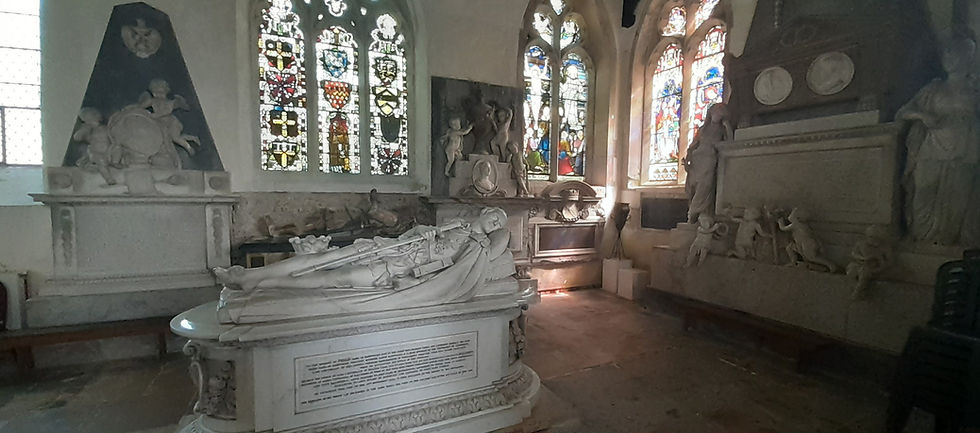Odds and Sods June 2025
- Gethin Thomas

- Jul 13
- 4 min read
It was sort of inevitable that at some point my Odds and Sods in a given month would be solely made up of phone photos. So here it is. It was just too hot to carry my camera everywhere so these are my summing up of June 2025 which was hot hot hot, and it still is now in July too.
This was a newly cut public footpath through a crop of wheat. These routes are ancient and are still (mostly) well maintained and kept navigable by the landowners.




My newly christened "noughts and crosses rock" at my favourite beach which is only exposed at very low tides.

This is Brixham and the old lighthouse at the end of the breakwater.

It was built in 1912 after the breakwater was extended, and why wouldn't you add Classical architectural details in cast iron?


On a visit to Cambridgeshire we visited the American Cemetery.
"This is the only military cemetery in the United Kingdom that commemorates American servicemembers and civilian volunteers who died in World War II.
Graves fan out across the lawn in sweeping curves. It’s a place of stillness and reflection. A stately memorial building contains a map room and devotional chapel.
Leaded-glass windows display the seals of U.S. States and Territories."



The Walls of the Missing list over 5,000 names. Some are highlighted in gold with added stars next to their names.
One such is Leon Vance.

His story is almost incredible. He flew in B-24's over occupied France on bombing missions ahead of the D-Day invasion. On June 5th 1944 his plane was hit by anti-aircraft fire, four crew were wounded and three of it's four engines were lost.
Vance himself was wounded nearly losing his right foot. The co-pilot managed to fly the plane back across the English Channel with the help of Vance. However it was too badly damaged to land safely so Vance ordered the crew to bail out over the sea in sight of land. He ditched the plane in the belief that an injured crew member was still aboard. The plane landed on water largely intact but Vance was trapped by his injured foot, in a rapidly sinking plane. An explosion blew him clear of the plane and he managed to swim to shore.
As if that was not enough, nearly two months later after recovering from his injuries, he was sent back to the United States on a transport plane for further treatment. On July 26th the C-54 disappeared with all on board between Iceland and Newfoundland.

"The recommendation that he be awarded the Medal of Honor was confirmed in orders on January 4, 1945, but his widow requested that the awards ceremony be delayed until the medal could be presented to their daughter. On October 11, 1946, Major General James P. Hodges, commander of the 2nd Bomb Division when Vance was assigned to it, made the presentation to Sharon Vance, age 3½, at Enid Army Air Base, Oklahoma."


Also in Cambridgeshire this is the very grand Wimpole Hall on the Wimpole Estate, now run by The National Trust. The house was begun in 1640 and sits in 3000 acres of parkland. Wimpole was listed in the Domesday Book of 1086. At that time there was a moated manor house set in a small 81 hectares (200 acres) deer-park.

The estate was owned by the Chichely family for 250 years beginning with Henry Chichele in 1428, the then Archbishop of Canterbury. Then came the Earls of Radnor in 1689, the Duke of Newcastle on Tyne in 1710, followed by the Earls of Oxford and Earl Mortimer, followed by the Earl of Hardwicke in 1740, then the Viscount Clifton. The titled ownership ended in 1942 when George Bambridge and his wife Elsie, the daughter of Rudyard Kipling took over the estate. Most of these changes of ownership seem to have been due to bankruptcy.

George and Elsie used the inheritance left to them by her father, and the royalties from his books, for the long-needed refurbishment of the house and grounds. During the War, for instance, the house had no running water nor electricity. During her time at Wimpole Hall, Elsie was known to become irritated by members of the public gathering too close to the house for picnics, so much so, she once returned to an offending couple's property and had her own picnic on their lawn. Elsie Bambridge bequeathed the house to the National Trust when she died in 1976. Wikipedia
Ironically, gifting the estate to the National Trust ensured that the public could have picnics on the lawns for ever.


It was very much an "Upstairs Downstairs" home. An army of servants would have maintained it and catered to the various owners over the centuries. This is the view of the front garden, with the end of the lawn about a mile away in the distance.


This is the view from the servants quarters where they were luckily situated at least semi underground rather than fully underground.

The kitchen garden is one of the largest I have ever seen.

The next door church is no longer part of the estate but contains the remains of many of its illustrious inhabitants, such as the Earls of Hardwicke, and a stained-glass window commemorating Thomas Agar-Robartes, eldest son of Thomas Charles, 6th Viscount Clifton and Mary, Viscountess Clifton of Lanhydrock, Bodmin, Cornwall.

The Chichely Chantry above is all that remains of the original 1390 chapel. The chantry's name dates to when the estate was owned by Henry Chichele and his relations' descendants. However, it was actually founded by the previous owner of the estate, Sir William de Staundon (MP, Master of the Grocer's Company, and Lord Mayor of London in 1392 and 1407) in c.1390.




Comments